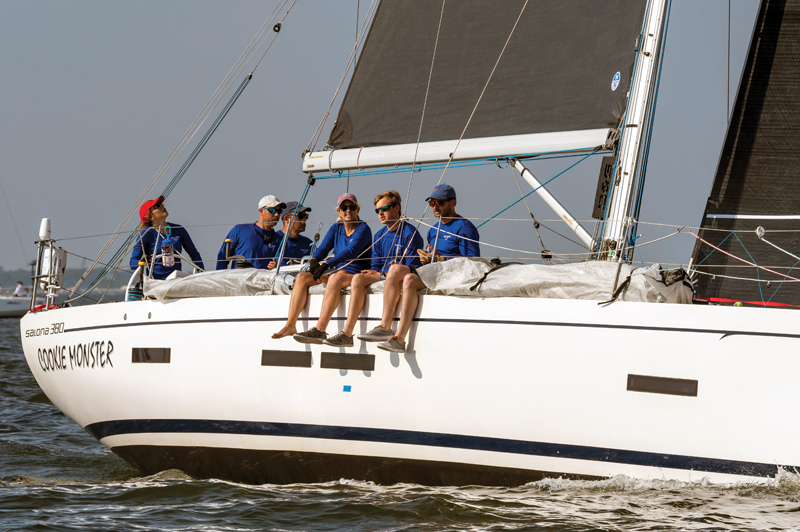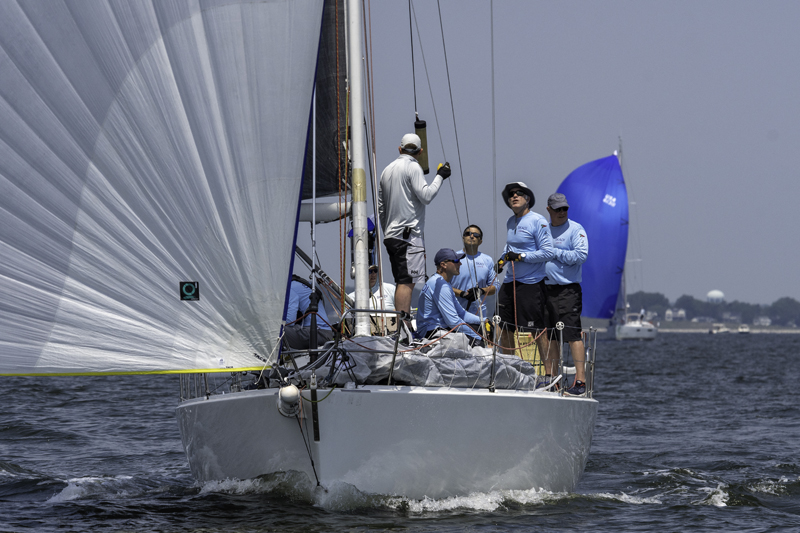Beyond the race requirements: skipper tips for offshore racing safety
As Chesapeake sailors, we’re fortunate to have multiple offshore racing options at home or on the East Coast. This June, the Eastport Yacht Club hosts its bi-annual Mustang Survival Annapolis Bermuda Ocean Race (June 7). Many Chesapeake racers deliver their boats to Newport, RI, to compete in the larger Newport Bermuda Race (June 21). In June 2025 Annapolis Yacht Club and Newport Yachting Center will host their bi-annual Annapolis to Newport Race (A2N).

Preparing for such endeavors takes months of planning and preparation, if not more than a year. Having done just one offshore race in my 35-plus years of racing, I’m certainly no expert on the subject. Professional sailing coach Jahn Tihansky gives an entire hour-long-ish presentation covering 11 different subject areas of offshore racing. So, one of the benefits of writing for SpinSheet is that I get to learn about a variety of topics by interviewing others like Tihansky, with far more experience and expertise and convey this knowledge to you.
Each offshore race has its own specific requirements for each boat, including safety training and certification such as CPR and Safety at Sea, as well as navigation and location equipment such as AIS, having a life raft onboard, and numerous other necessities. If you’re considering an offshore race as crew or skipper, reference the race requirements as early as possible to allow ample time to plan and prepare.
This article is not intended to rehash these requirements, nor serve as a comprehensive preparation guide. The insights and tips contained here serve more as some street smarts of experienced offshore racers based here on the Bay.
Crew Prep
As skipper of my J/120 Hot Pepper, I don’t take lightly the burden I assume for the safety and wellbeing of my crew. In speaking with several experienced offshore racers, I was humbled, impressed, and inspired to learn about the measures they’ve taken to prepare their crew for the high seas.
Todd Berget skippered his J/120 Skadi to win the A2N Race in 2023. He’s currently preparing to race in this year’s Newport to Bermuda Race. His advice was to get all of the crew certifications completed over the winter prior to the offshore race. He held multiple Zoom calls with his crew this past winter to plan crew positions, race requirements and other logistics so that the spring warming could allow focus on boat prep.
“Once the boat is ready to go in the water, we put together a practice schedule for the whole spring,” Berget noted. “We typically practice once or twice a week in April and May.”
The crew runs through all maneuvers repeatedly, with coaches onboard such as Jason Currie from Quantum Sails and Tihansky. “Having a coach onboard forces us to do the things we don’t want to do, like practicing crew overboard drills 10-15 times at night with the kite up using a cushion with a glowstick,” Berget noted.
Steve Hale captained Cookie Monster in its third offshore race with A2N in 2023 which followed Newport to Bermuda in 2022 and A2N in 2021. “We did a lot of practice last year for the A2N,” said Hale.
To gain the most realistic experience, he scheduled onboard training sessions starting as early as March to repeatedly execute a cadre of exercises such as using storm sails and crew overboard drills at night under spinnaker. Hale recommends practicing in early spring high winds and rain to get the crew comfortable with takedowns and sail changes before the summer lulls set in.
“Getting the spinnaker down in high winds is an important element of practice. It’s definitely top of the list of items to practice for when the wind is blowing and it’s raining,” Hale said. He also notes the benefit of identifying any crew that’s better suited on dry land or buoy racing long before the boat leaves the Bay.
On that note, seasickness is a very real concern, even among the most experienced sailors. Typical Bay conditions pale in comparison to the 10-foot rollers offshore races may present. Sick crew compromise the safety and effectiveness of the entire boat. To prepare for this, Hale requires all crew to use the Scopolamine patch starting the day before the race start. He prefers the Stugeron patch which has fewer side effects but is harder to obtain.

Safety Measures
Stressing again to refer to the specific safety requirements for each individual offshore race, several best practices emerged from the skippers I interviewed. Doug Ellmore owns the Canadian Sailcraft 30 Revolution which he’s currently prepping for the A2B this June.
“For regular weekly races, people come after work, getting familiar with the boat but not really practicing offshore sailing. Our intent is to do an overnight destination with continuous sailing, sleeping overnight, and practicing COB multiple times,” said Ellmore.
He has obtained a refurbished AED for his boat this year. Some of his crew will use personal AIS devices as well. He has replaced the lifelines on deck, refitted his jacklines to be centerline, and added more jacklines in the cockpit to keep crew onboard. His crew will wear PFDs at all times, including while sleeping. Ellmore has added reflective tape to anything that can go overboard and will have more throw gear in the cockpit than what the race requirements specify.
Boat Prep
The more offshore races a boat has done, the less prep it likely needs for each race. Some boat maintenance may be due anyway, so it’s difficult to say just how much work a boat may need. Ellmore replaced his standing rigging on Revolution this past winter. He also overhauled his head system and freshwater plumbing, serviced his seacocks, and converted his alternator to an external regulator so that he’d have a spare alternator.
Hale installed Li-Ion batteries and a large alternator to reduce engine run time to align with crew shift schedules. He replaced his halyards with contrasting black and white colors for better identification at night, since colored flecks all seem to look the same under red light. He built and installed pipe berths so more crew could sleep in the middle of the boat for better weight distribution. He also rebuilt and installed an old watermaker to reduce water weight.
Provisions
To reduce dependency on refrigeration, Hale packs one disposable Styrofoam cooler for each day with deep frozen meals in casserole pans that can be placed right into the oven to reheat and serve. He points out that freeze dried meals don’t save space or weight since water needs to be added anyway.
Testing Navigation and Electronics
It’s important to test equipment in all conditions well before race day. According to Hale, offshore data was a challenge on Cookie Monster. The Iridium satellite setup wasn’t reliable offshore, despite performing initial tests in the Bay. Ellmore is adding two 75W solar panels to the bimini of Revolution to supplement his 100-Amp-hour Battleborn for the house plus two additional 100-Amp lithium batteries onboard. He installed circuit breakers so that they can be isolated in a storm to avoid a total loss of electronics in the event of a lightning strike.
Learn More
Be sure to study your race’s individual requirements carefully. Sign up for the Safety at Sea Seminar. US Sailing also has resources available. Find an archive of offshore and safety articles at spinsheet.com. Professional coaches such as Currie or Tihansky are excellent resources as well. Be safe, and good sailing.
by Captain Steven Toole




